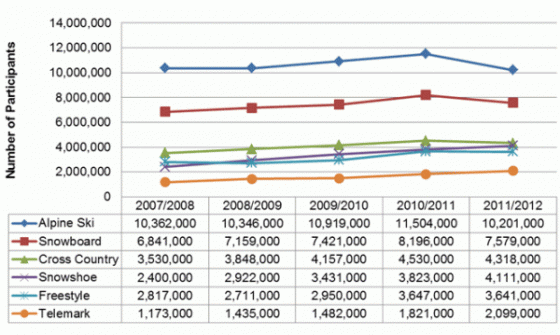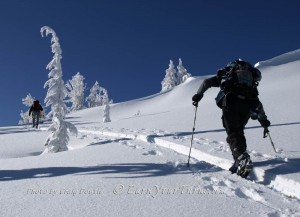SIA has released their annual survey results and the numbers are what you would expect, if you know how to interpret them. Any way you slice it, the number of people skiing was down for the 11/12 season compared to the 10/11 season. Considering last season got off to a late start, and the snowfall totals were well below average except in the Pacific Northwest, this is not an unexpected result.

Participation levels as determined by SIA (Snowsports Industries of America).
Image courtesy SIA & SkiingBusiness.com
What is unexpected is the growth in what SIA continues to categorize as telemark skiing. There was a time, over a decade ago, when telemark skiers were the dominant discipline in the larger overall category now referred to as backcountry skiing. Back then 70% of backcountry skiers were telemarkers and the two terms were synonymous for the purposes of a survey. Even though SIA claims that is no longer the case, their survey suggests otherwise. Ask any backcountry ski retailer how sales of telemark equipment are doing and you’re likely to hear the oft repeated, “tele is dead” mantra. Probe a bit further and they’ll admit it isn’t dead, but it is clearly no longer the leader in equipment sales. Alpine Touring equipment is the leader now, by as must as 80-90 percent, depending on who you ask.
So how could telemark skiing be growing if sales of tele gear are down and skiing overall declined last season? Consider two factors. First, if you ignore SIA’s insistence that their survey adequately distinguishs between telemark and backcountry, and instead equate them, then it is possible to accept the growth in spite of the lack of snow. The fact that there is no backcountry category, thus a lack of distinction between telemark and backcountry implies their equality.
Regardless of the semantics, how is it that backcountry, or what SIA calls telemark skiing, grew in a low snow year? It’s the economy, stupid! Hardcore skiers still want to ski, but when the snow is low and money is tight, they head for the backcountry.
Now that most skiers know you don’t have to become a pinheaded telemarker to earn your turns, back-, side, or slackcountry skiing, via AT gear, will continue to surge, especially as the economy circles the drain. When mainstream ski companies like Salomon, Atomic, Technica, Tyrolia, Elan, and Rossignol start creating backcountry boots and bindings that either means the backcountry is really going off, or its the only segment growing in a stagnating market.
Related Post
1.4 Million Telemark Skiers?
© 2012


3 comments
Another possibility is that many first time telemarkers are buying used equipment through private sales and that won’t show up in any retail figures.
He, he. Looks like some feathers got ruffled with my claim that interest in backcountry/telemark skiing is all based on economics. I’ll admit that’s a gross over simplification. I still believe it is a large part of the driving force for newbies, but fails to be the main attraction in the long run, although economics is still part of the overall equation. It’s just that in the long run, the cost of backcountry/telemark skiing is not just the price of admission (gear, access, travel), but the return on the investment. For that, backcountry delivers far more dividends than slope doping under the lifts. Treatise to follow as the season unfolds. 😉
Seems like they should change “tele” to “tele at resort” and add a “backcountry” category (which would include backcountry tele).